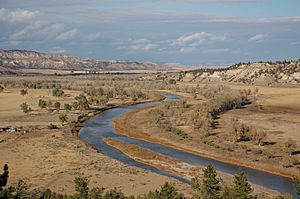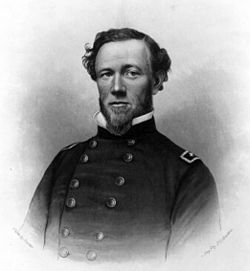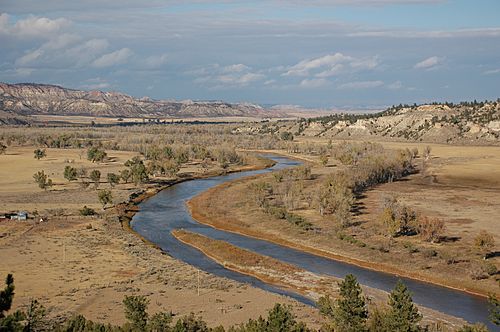Battle of Powder River facts for kids
Quick facts for kids Battle of Powder River |
|||||||
|---|---|---|---|---|---|---|---|
| Part of the Big Horn Expedition, Great Sioux War of 1876 | |||||||
 The Powder River looking north on the battlefield |
|||||||
|
|||||||
| Belligerents | |||||||
| Northern Cheyenne Oglala Lakota Sioux |
|||||||
| Commanders and leaders | |||||||
| Two Moon He Dog Little Wolf Wooden Leg |
|||||||
| Strength | |||||||
| 100–250 | 383 | ||||||
| Casualties and losses | |||||||
| 3 killed, several people later died of exposure 3 wounded |
4 killed 6 wounded 66 frostbitten |
||||||
The Battle of Powder River, also called the Reynolds Battle, happened on March 17, 1876. It took place in what was then Montana Territory in the United States. This battle started the Great Sioux War of 1876. It was an attack by Colonel Joseph J. Reynolds on a camp of Cheyenne and Lakota Sioux Native Americans. Even though the soldiers destroyed a lot of property, the attack was not well-planned. It likely made the Lakota Sioux and Northern Cheyenne even more determined to resist the U.S. government. The U.S. wanted them to sell the Black Hills and move onto a reservation.
Contents
Why the Battle Happened
The Treaty of Fort Laramie (1868) gave the Lakota Sioux and their Cheyenne allies a large area of land. This included the Black Hills in Dakota Territory and other lands in what is now Montana and Wyoming. These areas were just for the Native Americans. White people were not allowed to enter, except for government officials.
In 1874, gold was found in the Black Hills. This made the United States want to buy the Black Hills from the Sioux. The U.S. government told all Lakota and Cheyenne groups to come to their agencies by January 31, 1876. They wanted to talk about selling the land.
Some groups did not come. After the deadline passed, the Commissioner of Indian Affairs said that military actions should start against them. On February 8, 1876, General Philip Sheridan ordered generals George Crook and Alfred Terry to begin winter campaigns. They were to fight against the Native American groups who had not come to the agencies.
The Journey to Powder River
Brigadier General George Crook led the Big Horn Expedition. He marched north from Fort Fetterman in Wyoming on March 1. General Crook wanted to attack the Native Americans in their winter camps. This was when they were most vulnerable. People thought Sitting Bull, Crazy Horse, and their followers were near the Powder, Tongue, or Rosebud rivers.
Crook's force had 883 men. These included U.S. Cavalry and Infantry soldiers, civilian workers, scouts, and a newspaper reporter. Crook's main scout was Frank Grouard. He had lived with the Lakota and spoke their language.
The weather was extremely cold. Soldiers had to heat their forks to prevent them from freezing to their tongues. A blizzard on March 5 brought over a foot of snow. This slowed Crook's journey a lot. Temperatures were so low that thermometers could not even measure the cold.
Crook's group slowly followed the Bozeman Trail north. They reached Old Fort Reno on March 5. There, they set up a supply base. They left their wagons and some infantry soldiers behind. The cavalry then marched to Otter Creek.
On March 16, scout Frank Grouard saw two Native American warriors watching the soldiers. He thought they were Oglala Lakota and that Crazy Horse's camp might be nearby. Crook was told this. At 5 p.m., he split his command. He sent Colonel Joseph J. Reynolds with about 383 men. They had food for one day. They followed the trail of the two Oglalas southeast toward Powder River. Crook stayed with about 300 men.
That night, Frank Grouard and other scouts followed the trail in the snow. It led them to a Native American village. They said it had more than 100 lodges on the west bank of Powder River. The scouts immediately told Colonel Reynolds this information.
Planning the Attack
The weather was freezing cold. Reynolds planned for one group of soldiers, led by Captain Henry E. Noyes, to go down steep hills. They would go to the valley floor. One company, led by Captain James Egan, was to attack the south end of the village. The other company, led by Captain Noyes, was to capture the Native American horses. There were an estimated 1,000 horses.
A second group, led by Captain Anson Mills, was to attack the village from the west at the same time. The last group, led by Captain Alexander Moore, was to take positions on the ridges north and west of the village. This was to stop Native Americans from escaping in that direction.
The Battle Begins
The village was actually further north than the soldiers expected. Because of this, only Captain James Egan's company of 47 men charged into the village from the south. The other companies were delayed by the distance and rough land.
The battle started at 9:05 a.m. on Friday, March 17. The Native Americans, who were Northern Cheyenne and some Oglala Sioux, were surprised. Wooden Leg, an 18-year-old Cheyenne warrior, remembered the attack. He said, "Women screamed. Children cried for their mothers. Old people tottered and hobbled away to get out of reach of the bullets." He also said, "Braves seized whatever weapons they had and tried to meet the attack."
The Cheyennes quickly moved their women and children to safety. They then retreated north out of the village. They took positions on the bluffs overlooking the village. From there, they fired at the soldiers in the village. Several soldiers were wounded early in the battle. Many horses were killed or wounded.
Captain Egan's company in the village was joined by more soldiers. When Colonel Reynolds arrived, the soldiers were still under fire. He ordered everything in the village to be destroyed. This included dried buffalo meat. During this time, two soldiers, Private Peter Dowdy and Private George Schneider, were killed.
The village and supplies were hard to burn. When the fire reached gunpowder and ammunition, they exploded. Lieutenant John Gregory Bourke, an aide to General Crook, noted how many valuable things were in the village. He saw "bales of fur, buffalo robes, and hides decorated with porcupine quills." Some soldiers took buffalo robes even though it was against orders, because they were freezing. Bourke later estimated that 66 men, including himself, suffered from frostbite.
Throughout the day, soldiers gathered over 700 Native American horses. The battle lasted five hours. Around 2:00 p.m., after the village was destroyed, Reynolds ordered his soldiers to leave. They crossed to the east side of the frozen Powder River. Private Michael I. McCannon was killed around this time.
During the retreat, Private Lorenzo E. Ayers was badly wounded. He was left behind in the village. Two other soldiers, Saddler Jeremiah J. Murphy and Blacksmith Albert Glawinski, tried to rescue Ayers. But he was later killed by Native Americans. By the end of the battle, four soldiers had died and six were wounded. Murphy and Glawinski later received the Congressional Medal of Honor for their bravery. Hospital Steward William C. Bryan also received the Medal of Honor.
The last part of the battle happened about 1 mile (1.6 km) south of Hospital bluff. Lieutenant William C. Rawolle, leading the rear guard, had eight of his men get off their horses to form a defensive line. One sergeant reported shooting a Native American warrior from his horse.
Colonel Reynolds left the bodies of three dead soldiers behind. One was in the village, and two were at the second field hospital. He also left the badly wounded Private Ayers. The soldiers marched about 21 miles (34 km) south that afternoon and evening. They crossed the frozen Powder River many times. They arrived at the meeting point with General Crook after 9:00 p.m., very tired. However, General Crook was not there. He had camped 10 miles (16 km) northeast and had not told Reynolds where he was.
The Cheyenne recaptured over 500 of their horses the next morning, March 18. No guards had been placed on them. Reynolds finally met with General Crook around 1:30 p.m. that day. The reunited group returned to Fort Fetterman, Wyoming Territory, arriving on March 26, 1876.
The Cheyenne and Lakota lost only a few warriors killed and wounded. But they lost most of their belongings. The warrior Wooden Leg said, "The Cheyennes were rendered very poor. I had nothing left but the clothing I had on... My eagle wing bone flute, my medicine pipe, my rifle, everything else of mine, were gone." The women and children walked for several days to reach Crazy Horse's village. This was farther north near the Little Powder River. They were given shelter and food there. On the way, several Cheyennes froze to death.
The army said the village had about 104 lodges, including tipis and wikiups. Cheyenne accounts said the village had about 40–65 tipis and about 50 other structures. Between 100 and 250 Native American warriors fought in the battle. There were about 383 United States soldiers and civilians present.
What Happened After the Battle
Colonel Reynolds was accused of not doing his duty. He was blamed for not fully supporting the first attack. He was also blamed for burning captured supplies like food, blankets, and buffalo robes instead of keeping them for the army. Most of all, he was blamed for losing hundreds of the captured horses.
In January 1877, Reynolds had a court-martial in Cheyenne, Wyoming Territory. He was found guilty of all three charges. He was suspended from his rank and command for one year. However, his friend, President Ulysses S. Grant, canceled the punishment. Joseph J. Reynolds never served again. He retired due to disability on June 25, 1877. This was exactly one year after the main battle of the Great Sioux War, the Little Bighorn.
Crook's and Reynolds' failed expedition and their inability to seriously harm the Lakota and Cheyenne at Powder River likely made Native American resistance stronger.
Medals of Honor
Three Medals of Honor were given to soldiers for their brave actions during the battle:
- Hospital Steward William C. Bryan, 2nd United States Cavalry Regiment. He continued to fight on foot after his horse was killed. He also saved two wounded friends from being captured.
- Saddler (Private) Jeremiah J. Murphy, 3rd United States Cavalry Regiment. He tried to save a wounded friend.
- Blacksmith (Private) Albert Glawinski, 3rd United States Cavalry Regiment. During a retreat, he chose exposed positions as part of the rear guard.
Casualties
Native Americans
- Killed: Eagle Chief (Northern Cheyenne), Whirlwind (Northern Cheyenne), one unknown Oglala Lakota warrior. Several women and children later died from the cold after the battle.
- Wounded: Braided Locks (Northern Cheyenne), one unknown Northern Cheyenne warrior, one unknown elderly Oglala Lakota woman.
United States Army
- Killed: Private George Schneider, Private Peter Dowdy, Private Michael I. McCannon, Private Lorenzo E. Ayers.
- Wounded: First Lieutenant William C. Rawolle, Sergeant Charles Kaminski, Corporal John Lang, Farrier Patrick Goings, Private John Droege, Private Edward Eagan.
The Battlefield Today
In the early 1900s, a teacher named Frank Theodore Kelsey claimed land along the Powder River. This land included the battle site. Kelsey later became a Montana state senator. He helped get a monument for the soldiers placed near the village site in 1934.
Today, the Powder River / Reynolds Battlefield is on private land. It is located at [45 05 18 N 105 51 28 W]. You can reach it by Montana Secondary Highway 391 (Moorhead Road), along the Powder River in Powder River County, Montana. It is about 1 mile (1.6 km) north of the community of Moorhead, Montana, and about 34 miles (55 km) southwest of Broadus, Montana.
Monuments to the Battle
In 1919, a historian named Walter M. Camp learned that the four soldiers killed in the battle had been left on the field without headstones. With help from others, headstones were made and sent by train to Arvada, Wyoming.
In 1920, Camp said the headstones would be placed on the battlefield the next summer. But they stayed in storage in Wyoming for another 14 years.
In 1933, Camp's words were reprinted. A man named D.C. Wilhelm from Gillette, Wyoming learned that the headstones were still in storage. In early 1934, with help from the American Legion and Montana State Senator Frank T. Kelsey, a stone and concrete monument was built. It had the soldiers' headstones embedded in it. The monument was dedicated on Memorial Day, May 30, 1934, and it still stands today.
Across the road from the soldiers' monument is the Cheyenne monument. It is a sandstone boulder painted with the flag of the Northern Cheyenne tribe.
Who Fought in the Battle
Native Americans
- Leaders: Chiefs Old Bear, Two Moon, and Little Coyote (Little Wolf).
- Number of warriors: About 60 to 250.
- Tribes: Northern Cheyenne and Lakota Sioux.
United States Army
- Commander: Colonel Joseph J. Reynolds, 3rd Cavalry.
- Number of soldiers and scouts: About 383.
- Units: Parts of the 2nd United States Cavalry Regiment and 3rd United States Cavalry Regiment.
The Battle in Movies
In 1951, Hollywood made a movie called Tomahawk in the United States. In the United Kingdom, it was called Battle of Powder River. This movie starred Van Heflin, Yvonne De Carlo, Jack Oakie, and Rock Hudson. However, the story was actually based on events from Red Cloud's War (1866–1868), not the 1876 Battle of Powder River.






